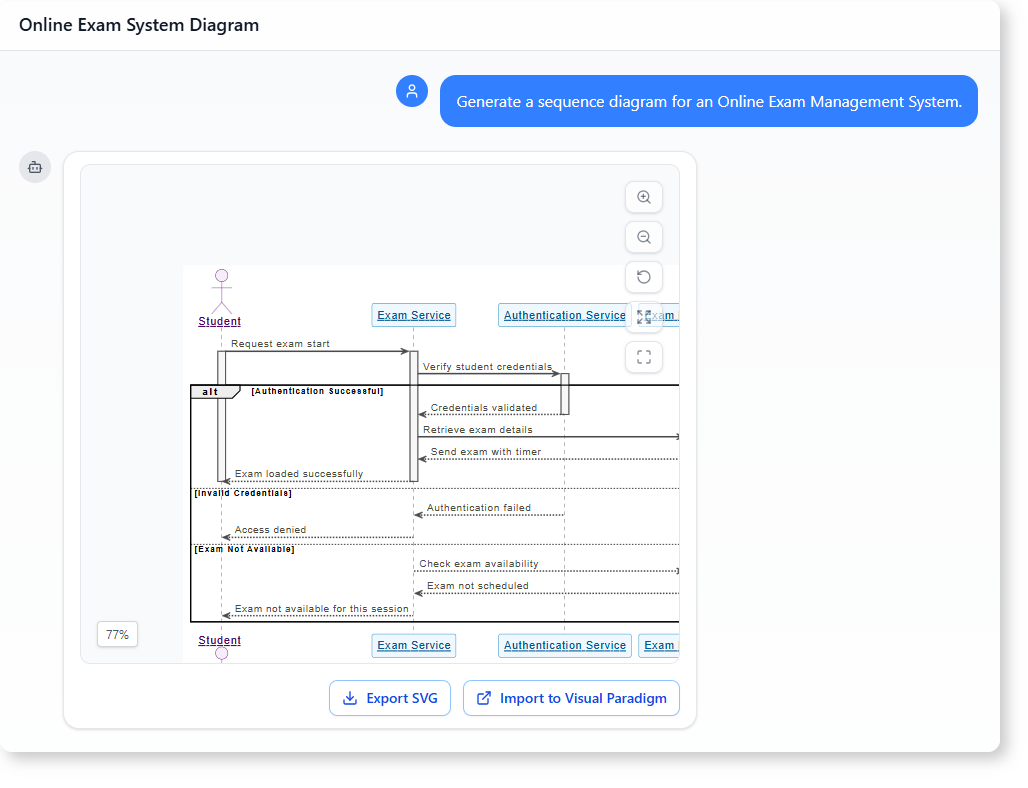Now Reading: How to Generate a Sequence Diagram for an Online Exam Management System with AI-Powered Modeling
-
01
How to Generate a Sequence Diagram for an Online Exam Management System with AI-Powered Modeling
How to Generate a Sequence Diagram for an Online Exam Management System with AI-Powered Modeling
Why a Sequence Diagram Matters for Online Exam Systems
When building an online exam management system, the flow of interactions between users and services must be clear. A sequence diagram helps break down these steps—what happens when a student tries to start an exam, how credentials are verified, and what happens if the exam isn’t available.
This isn’t just about showing components. It’s about understanding the real-time interactions that determine whether a student can proceed or is blocked.
Using an AI-powered modeling software, you can describe the system behavior in plain language and get a detailed sequence diagram as a result. No prior drawing skills are needed.
The User’s Journey: From Idea to Diagram
The user is a software developer working on a prototype for an online exam platform. They need to understand the flow of an exam start process, especially around authentication and session validation.
Instead of manually drawing the interactions, they decide to use AI to generate the sequence diagram. The goal is to get a clean, accurate representation of how a student requests an exam, how credentials are checked, and how the system responds.
Step-by-Step Prompt Flow
- Prompt: “Generate a sequence diagram for an Online Exam Management System.”The AI interprets this as a request for a visual flow that includes the main actors and services involved. It identifies the key participants: the student, the exam service, the authentication service, and the exam repository.
- AI Response: A sequence diagram is created showing the interaction flow from the student requesting the exam to the system validating credentials and either loading the exam or denying access.The diagram follows a natural flow: the student sends a request to the exam service, which then verifies credentials with the authentication service. Based on the result, the system checks if the exam is available and responds accordingly.
- Follow-up Prompt: “Summarize the main interactions and flows shown in this sequence diagram.”The AI provides a clear breakdown of the two main paths:
- Successful Authentication: The system validates the student’s credentials, retrieves exam details, and sends them back with a timer.
- Authentication Failure or Exam Unavailability: The student is denied access, or receives a message that the exam isn’t scheduled.The summary highlights decision points and error handling, which are critical for building a robust system.
What the AI-Powered Modeling Software Delivers
With this tool, the developer doesn’t need to spend hours sketching components or writing UML code. Instead:
- They describe the system in simple terms.
- The AI creates a sequence diagram that shows actor interactions and decision branches.
- The diagram clearly separates valid and invalid paths, including error conditions.
This is especially useful for stakeholders who don’t have a modeling background. They can quickly grasp how the system behaves under different scenarios.
The resulting diagram is not just a static image—it reflects real-time data flows, message passing, and system states. This level of clarity supports better communication, debugging, and future development.
How This Helps in Real-World Development
This example shows how an AI modeling tool can support the entire development lifecycle:
- During design: Quickly validate interaction patterns.
- In testing: Identify failure paths and edge cases.
- In documentation: Provide a visual reference that’s easy to share.
Instead of relying on static documentation, teams can now use AI to generate accurate models with just a few sentences.
Key Features That Make This AI-Powered Modeling Software Effective
- Natural language input: Describe your system in plain English.
- Instant visual output: Get a sequence diagram in seconds.
- Clear interaction breakdown: The AI identifies actors, messages, and decision points.
- Error path handling: Shows what happens when authentication fails or exams aren’t scheduled.
This is not just a sequence diagram tool. It’s an interaction flow generator that understands real-world scenarios.
Compare with Traditional Modeling Tools
| Feature | Traditional UML Tools | AI-Powered Modeling Software |
|——–|————————|——————————-|
| Input Type | Code-based (e.g., PlantUML) | Natural language prompts |
| Learning Curve | High – requires syntax knowledge | Low – just describe the flow |
| Output Accuracy | Depends on correct syntax | Based on system logic and context |
| Time to Generate | Minutes to hours | Seconds |
| Use by Non-Experts | Limited | Fully accessible |
Ready to Map Out Your System’s Interactions?
Give our AI-powered modeling software a try at Visual Paradigm’s AI Chatbot today!.
Frequently Asked Questions
Q1: Can I generate a sequence diagram for any system using natural language?
Yes. Whether it’s an online exam system, a checkout process, or a data sync flow, you can describe the interactions in your own words and get a sequence diagram automatically.
Q2: Does the AI understand different types of system responses like errors or success?
Yes. The AI recognizes decision branches and generates appropriate flows for both successful and failed scenarios.
Q3: How does the AI ensure the diagram reflects real user behavior?
By analyzing the language used in the prompt, it identifies actors, actions, and conditions. It then builds logical sequences that mirror how systems typically respond.
Q4: Is this tool suitable for use in team meetings or presentations?
Absolutely. The generated diagrams are clear, easy to read, and can be used to explain complex interactions without requiring technical expertise.

